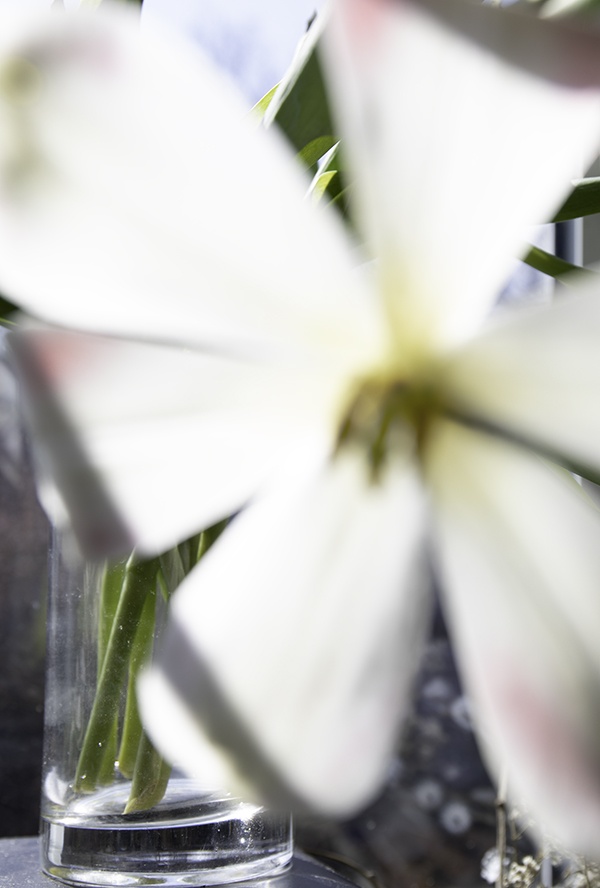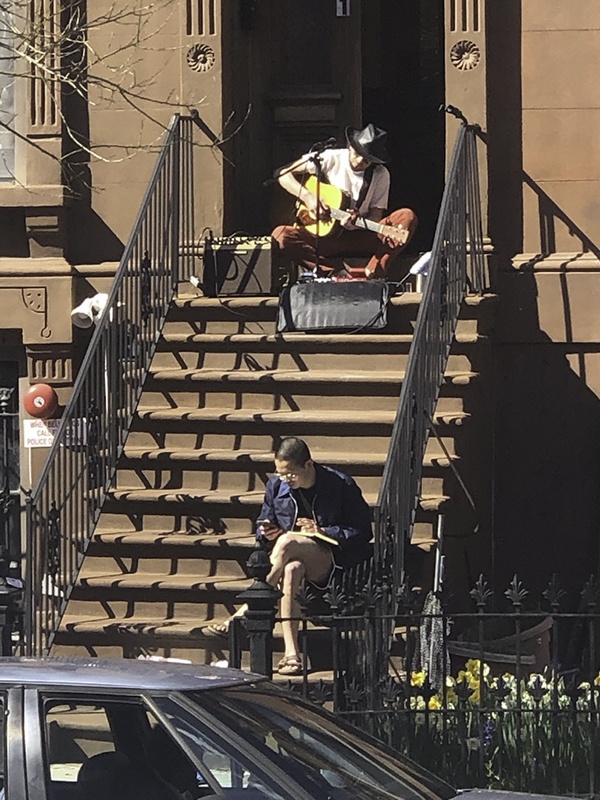An Ear at the Edge of a Chasm by Peter Brock

A tulip’s last "Hurrah!"
When I heard that Art Basel Hong Kong would be held entirely online, I dismissed the news with the same flippancy that I typically apply to headlines about multimillion-dollar auction sales. The uppermost echelon of art commerce holds very little interest for me and most artists that I know, and this move registered as predictable rather than consequential. After all, the slow-motion convergence of art fairs and online shopping has been underway for a long time. I obviously hadn’t yet grasped that this was a tipping point in what would soon become the complete abandonment of physical exhibitions for the foreseeable future. Neither did I realize that this was an early harbinger of the economic upheaval that has now catastrophically impacted the livelihoods of millions. Despite my frantic consumption of coronavirus-related news, the severity of this pandemic only registered fully when it cost me my job at the studio of a prominent artist whose work was shown at several editions of that ‘far-away fair’ in Hong Kong.
Online viewing rooms and virtual exhibitions are now the only way to see art. While this development has many obvious downsides, it also presents a valuable opportunity to confront the habits formed by this way of seeing. Viewing art on the internet has become such a common way of ‘seeing’ shows today that the determinant qualities of this format are practically illegible to us. The sudden absence of in-person art experiences pressurizes the role of online viewing because there is no parallel activity to alleviate its shortcomings. These circumstances have caused me to reflect on the psychic pressures that browser windows and social-media feeds exert on my behavior as a viewer, even when I’m not looking at a screen.
The internet, and social media in particular, is a space where activities of looking and judging happen in such tight proximity to each other that repetition erodes the distinction between them. The structural imperative toward forming and expressing judgments in response to images is most visible in the case of Instagram, but the same principles operate throughout social media. Scrolling through the feed involves passing rapid judgments and expressing them through the flick of a finger. The time that we linger is an expression of our level of interest. Responding to a post is the culmination of the encounter and typically the end point of our engagement with the image. Within this framework, the purpose of looking is to determine if the object of our attention is worthy of a response, and then to quickly move on. While people certainly form judgments on visual encounters IRL, social media provides the ability to instantaneously register these verdicts through liking, sharing, or commenting. We articulate our subjectivity through a high volume of relatively inconsequential affirmations and dismissals. These fast-paced interactions can be tremendously socially enriching and entertaining, but also boring and draining. That these rewarding experiences occur intermittently amidst a deluge of forgettable content explains the addictive power that drives average social-media consumption to well over two hours per day. [1]
Conditioning consumers of visual culture to be fast-scrolling and quick-reacting serves the interests of social media companies who sell our attention to advertisers. But the habits we develop online are not confined to the screen. I’ve noticed a familiar type of impatience and urgency toward judgment creeping into my visits to museums and galleries over the last few years. This nervous energy works against my capacity to be a receptive viewer by lowering my tolerance for indeterminacy. The most precious time that I spend with artworks is the interval during which I don’t yet know what to think, much less how to react to, what I am experiencing. I have found myself struggling against the imprint of time spent on platforms designed to provoke a high volume of low-quality encounters. Even when I crave the delightful disorientation that art can sometimes generate, I have to fight back this intrusive urge to rank my level of interest and decide whether or not to move on. This process of forming an opinion is nothing new, but the habitual acceleration of these circuits works against aesthetic and cultural experiences that require duration.
Ranking and comparison are baked into the DNA of the internet, and it can be hard to escape the influence of this quantitative logic. Even art blogs and gallery viewing rooms, which don’t have obvious pathways for expressing judgment, can be tainted by the adjacent activities of evaluation and comparison that happen online. The ease with which we can look up an artist’s exhibition history and critical reception effectively makes these career assessments part of what it means to be a viewer of artwork on the internet. It could be my ambition and vanity, but I feel like it’s impossible to use the internet without feeling some form of jealousy. The visibility of others sparks a desire to be seen. That the layout of a browser is built for multitasking further complicates the conditions of online viewing. The next tab over likely contains my credit card balance, a chicken recipe, or some dumb thing that I’m contemplating buying. People are often scatterbrained without their devices present, but the screen literally displays, and thereby reinforces, this tendency toward distraction. However, the majority of exhibition documentation tries to simulate the sober, antiseptic uniformity of an empty gallery with perfect lighting.

Brooklyn being Brooklyn
Since beginning my own quarantine, I’ve noticed a subtle shift in my relationship to the laptop screen. I’ve become a more patient viewer as a result of two overlapping developments: the unavailability of in-person art experiences and my complete reliance on videoconferencing to communicate with my friends and family. Seeing the faces of my loved ones regularly appear on the same device on which I’m accustomed to browsing exhibitions, or coveting a new pair of running shoes, has softened my gaze. The empathy and care that these people inspire in me repels some of the frenetic judgmentalism that thrives online. When I look at documentation these days, I’m less concerned with forming an opinion about an individual artist or their work. I am also less likely to focus on the markers of social capital and career advancement. I still have reactions to what I see, but they occur with the awareness that even solo exhibitions are a collective effort. I notice myself putting more effort into imagining all of the unseen contributions and compromises that every exhibition involves. While this has been true all along, the individualism and narcissism that underlie the most profitable and therefore visible aspects of the internet tend to obscure this fact.
Today I spent a while scrolling through an online viewing room hosted by David Zwirner gallery. The presentation, titled “Platform”, features two artworks each from twelve artists represented by smaller New York galleries. The spaces are almost all ones that I’ve followed closely for a number of years. I know the physical dimensions of these galleries and many of the people who work in them. Seeing the artists’ work and faces – there are portraits and descriptions that accompany the images – in the context of David Zwirner’s ultra-slick website was strange but enjoyable. It felt like bumping into a friend on the subway only to find them dressed awkwardly in a business suit, as if they were about to appear in court. In this novel context, Brandon Ndife’s work held my attention. The sculptures teeter at the cusp of specific and generalized representation. Recognizable vegetal and organic forms appear to be undergoing transformations somewhere in between decay and very slow growth. Their murky fertility reminds me of peering into my mom’s compost bucket as a child. The images of Ndife’s sculptures suggest enough of their forms and texture to engage my curiosity, but the encounter was also mildly frustrating. I want to know how my body might react to their presence, but I have to settle for a detailed record of their surfaces.
There is something so nourishing and attractive about experiencing aesthetic statements that have not yet been fully interpreted or contained. However, the carefully chosen images and cleverly written blurbs in these viewing rooms bestow the guise of certainty on works whose meanings are still unfolding. Placing written language directly adjacent to the images exaggerates the authority of these interpretations. The combined effect of these conditions can be to present individual artworks as finished products that don’t need anything from us as viewers other than to behold them – or perhaps purchase them. The mechanics of this format have the unintended consequences of downplaying the fluidity of aesthetic experience and diminishing the role of viewership in shaping interpretation. It may be impossible to translate the physical experience of art onto the screen without such compromises, and I appreciate the pressing need for galleries to adapt their business models in order to survive the fallout from this pandemic. There will likely be many waves of improvements in these interfaces and the quality of documentation. Immersive environments and virtual reality could revolutionize online art experiences in dramatic ways. Each of these developments will also spur behavioral changes, and some of these might be difficult to anticipate. While technological progress generates excitement at the moment its new uses become clear, it takes longer to recognize the ways in which the tool is actually controlling the user.
Peter Brock is an artist based in Brooklyn, NY.
Image credit: Peter Brock, NY; the title "An Ear at the Edge of a Chasm" refers to Roberto Bolaño, 2666, trans. Natasha Wimmer (New York: Farrar, Straus & Giroux), p.419.
Notes
| [1] | J. Clement, “Daily Social Media Usage Worldwide 2012–2019,” https://www.statista.com/statistics/433871/daily-social-media-usage-worldwide/. |
